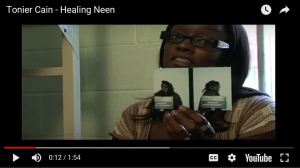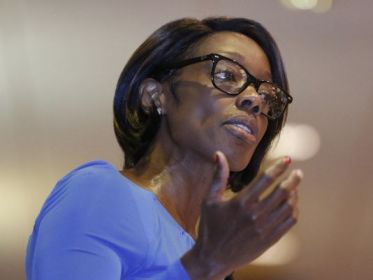
Tonier Cain. Photo: Yi-Chin Lee/USA TODAY NETWORK-Wisconsin
It’s not that my own trauma was triggered, though that happened.
It was the way she spoke about being let down so often by the systems she was often in and how often she was re-traumatized by them.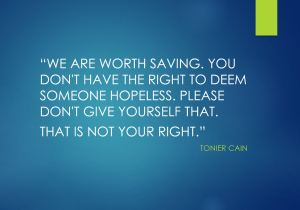
It’s the way she challenged my thinking so that I can no longer think about adverse childhood experiences without thinking about all of the ACEs – adverse childhood experiences and adverse community experiences and how intertwined they are.
ACEs comes from the CDC-Kaiser PermanenteAdverse Childhood Experiences Study (ACE Study), groundbreaking research that looked at how 10 types of childhood trauma affect long-term health. They include: physical, emotional and sexual abuse; physical and emotional neglect; living with a family member who’s addicted to alcohol or other substances, or who’s depressed or has other mental illnesses; experiencing parental divorce or separation; having a family member who’s incarcerated, and witnessing a mother being abused.
The ACE Study found that the higher someone’s ACE score – the more types of childhood adversity a person experienced – the higher their risk of chronic disease, mental illness, violence, being a victim of violence and several other consequences. The study found that most people (64%) have at least one ACE; 12% of the population has an ACE score of 4. Having an ACE score of 4 nearly doubles the risk of heart disease and cancer. It increases the likelihood of becoming an alcoholic by 700 percent and the risk of attempted suicide by 1200 percent. (For more information, go to ACEs Science 101. To calculate your ACE and resilience scores, go to: Got Your ACE Score?)
Other ACEs include racism, witnessing violence outside the home, bullying, spanking, losing a parent to deportation, living in an unsafe neighborhood, and involvement with the foster care system. Other types of childhood adversity can also include being homeless, living in a war zone, being an immigrant, moving many times, witnessing a sibling being abused, witnessing a father or other caregiver or extended family member being abused, involvement with the criminal justice system, and attending a school that enforces a zero-tolerance discipline policy.
But there’s also adverse community experiences, which makes up the “pair of ACEs” that Wendy Ellis describes.
I have to admit that when I first heard about the “pair of ACEs” I was confused and honestly, kind of annoyed.
I thought about how hard it is to explain what ACEs are. It takes at least three paragraphs for a story, a half hour in a PowerPoint presentation, and I thought, we can’t add another thing to the discussion or we’ll lose people. It’s not like the ACE Study and survey were an overnight sensation. It’s been two decades and many people still don’t know what ACEs are. How can we add community violence, racism and all kinds of oppression to every talk or article?
That’s so privileged of me, isn’t it? I think so. And I’m sorry for being so dense for so long. I sat on the yoga mat saying, “I get it now” and it wasn’t just in my head, mind or brain, but in my gut. I felt her words. I hope you can as well. Here are some excerpts from Tonier Cain’s talk.
TONIER CAIN: DO WE TRULY BELIEVE IN THE PEOPLE WE SERVE?
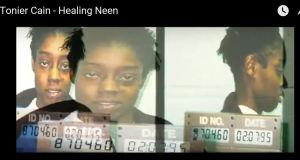
“If you see this woman come through your system, in your program, on your caseload back and forth, 83 arrests, 66 convictions, 19 years of drug addiction, right, even longer alcoholism, homelessness, lost all her kids, mental health consumer. Nineteen years. This is the history that’s in your chart that you read when she walked in the door. She’s sitting across the desk from you looking like that. Truthfully, I want you to be honest with yourself, I need to know would you be able to look at her and see me today?
Do we truly believe in the people that we serve? Can we see them past, their issues and their trauma?
When a paramedic is called to someone in medical distress, the first thing they do is check for signs for life, even if there are no signs of life. The first thing that they do is start to work to resuscitate that person and they do it tirelessly, not willing to give up easily. Why are we sometimes willing to give up so easy on people that got breath in their body? Why don’t we work hard to resuscitate their lives?
This is my belief. Nobody can change my mind. We are created in the image of the almighty God. We are worth saving. You don’t have the right to deem someone hopeless. Please don’t give yourself that. That is not your right.
So again, I ask, would you be able to look across the desk, after reading my chart, could you look across your desk and see her and imagine this woman on the red carpet in Hollywood ready to receive an award, constantly trying to create things that make a difference, that give hope?”
Tonier Cain’s talk demonstrates why being informed by trauma survivors is critical and required by anyone hoping to be trauma-informed. As we figure out how to apply ACEs science in our family and social service, educational, and criminal justice systems, we need to be well schooled in how ACEs have been treated/mistreated in the past or we run the risk of repeating mistakes and perpetuating pain rather than supporting and creating self-healing individuals and systems.
RE-TRAUMATIZED
“Now I want to talk to you about being re-traumatized with the multiple systems I’ve been in. Again, this is my own personal story. This is not a personal attack for anyone in their profession. Are we cool?….
I was, they called me the community crack ho. I was the person that was homeless on the street. I was the person that was never ever allowed to go in people’s houses. I was the person you see last thing at night or first thing in the morning. Waiting for a trick or waiting to get high. That was me. I was dirty. I was smelly. I was disgusting. That was me. They couldn’t see anything past that.”
LABELS
“I failed to understand what was wrong with me. People kept calling me crazy. They called me Crazy Neen on the street and t
hey kept telling me I needed medication. So I would checked myself into our voluntary 72-hour mental health unit at our county hospital.
It would depend on when I went. If I went on a Wednesday, I was schizophrenic. If I went on a Monday, I was bipolar. If I went on a Tuesday, it was borderline Tuesday. It was always a different diagnosis, but it was the same psychiatrist.
I would ask him over and over again, ‘Well how do you know this? How do you know this?’ I would explain to him again, ‘I’ve been up for seven days straight smoking crack cocaine.’ See, they never let the street narcotics out of my system before they truly gave me an assessment or evaluation.”
SUBSTANCE ABUSE “RECOVERY”
“I have been in 31 other 28-day programs and they all did the same thing. It would take them a whole week to tell us what we better not do. Around the second week, they would start to give drug education courses. They wanted us to know the natural names of the drugs we were putting in our system. Some programs would actually go all the way back and tell you where the drugs originated from. By the third week they show you homemade utensils that are unsafe.
Please note the word unsafe because as addicts we do care about being unsafe. You know unsafe things that people make that are unsafe. Unsafe. Unsafe.
Finally, when you graduate, they tell you how it affects your brain. I don’t need to know what it used to be called. I need to know what it’s called now because when the movie starts playing in my head (of past abuse), if I don’t go out and find what it’s called now and get it, I’m probably gonna blow my brains out. I need to get it before I take my life because I can’t stand that movie. I know how to get (drugs) in my system. That’s why I’m in your drug program. And who cares how it affects my brain? Someone tell me how to live a different life, how not to come back and forth into the system.”
Note: For more details about the movies that were playing in Tonier Cain’s head, check out the Healing Neen documentary.
INTAKE
“But you know with this first 28-program I was court ordered to, I felt there was a glimmer of hope because I seen people talking and they was talking positive. They were looking good. I got excited, If you can help them you can help me. So they say, ‘Cain’. They call me Cain. ‘Cain. The intake worker is ready for you.’
I go in to see the intake worker and this woman pulls out the file and this is what she did.
‘Ms. Cain, have you ever been a victim of domestic violence?’
I said, ‘Lady every man I had went up side my head.’
She said, ‘Is that a yes?’
And she just checked the box.
And then she said, ‘Ms. Cain, have you ever been a victim of sexual abuse?’
I said, “Lady, I’ve been beat and raped so many times I can’t even count them. She checked the box on this one page intake form, stapled it into the file, closed the file never to be seen again. It wasn’t even translated into my treatment plan.
I was subjected to violence by the hands of men. And given access to a male counselor.
If you don’t get anything out of my presentation please get what I’m about to tell you. You guys ready? Come on, you ready?
When we talking to your programs, to your system, to your facility, guess what? We come with the hope that you know what you are doing.
Half of us don’t have the willingness or the desire to wake up every single morning, but when we hobble through those doors broken in spirit and mind and body, we expect you to know what you are doing. So if you tell me this man is the best thing for me, who am I to argue? You’re the expert.”
ABUSE OF POWER
“So I completed this program successfully. I graduated, first time I graduated anything in my life. I felt proud. I could not wait to get back to after care even though they deposited me in my drug-infested neighborhood. I could not wait to get back to say I was clean. I stayed clean for the first week. I couldn’t believe it, went back to that second after care, I was able to get a ride there but I couldn’t get a ride home.
My drug counselor who I was assigned to at this program I was court ordered to, he offered me a ride home but he made a pit stop to push me down and rape me. And when he pulled me up by my hair he said, ‘No use in telling anyone. You just a crack head and prostitute. You’re nothing.’ And he threw me to the ground.
“Maybe when we understand the prevalence of trauma — up to 93% of incarcerated girls have been exposed to emotional, physical sexual abuse — given my answers to that one-page intake form, maybe, just maybe a male counselor wasn’t the best decision for Tonier Cain after all – and that could have been prevented.”
LOCK UP
“One of the worst things you can do to someone who is a victim of abuse and neglect is put them in a room, shut the door and walk away. See, because my issue with my mother was always triggered and no one is helping me to identify, address or treat my trauma, and so I do the only thing Tonier knows to do, is to attack and go into my survival mode.
And my survival mode has always told me to fight because I didn’t know there was any other way.
So when someone came with that tray of medication or food I smacked it out of my face. Then you’re on a walkie-talkie calling and talking in code and a bunch of men are running towards me.
Do you truly understand what I am saying? They were running towards me to restrain me. They were restraining a rape victim — somebody who has been held down multiple times — causing more trauma. Layers and layers and layers taking me even further away from the possibility of healing or recovering, not intentionally, I know, but because we don’t understand the impact of trauma. We sometimes cause more harm, making it impossible for people to heal.”
Note: Tonier Cain gave several examples of being re-traumatized by multiple systems. These are just a few examples. She also shared what helped her heal.
TRAUMA-INFORMED HEALING
“I didn’t think these people could help me, but they said I could keep my baby with me. (I said) ‘Sign me up.’ In my mind, if only I could hold on to this one a little longer than the last one, if I can keep this one for more than three hours things would be different….
So I went to this program and I talked about all the trauma I experienced in my life. The neglect. The abandonment. See, they said, ‘Tonier, everything that happened to you as a child, you didn’t do to yourself.’ And I started with the first trauma in my life, the issue with my mother. I talked about it, I cried about it some sessions, I came to the realization, ‘Hold up. My mother’s lack of love for me is who she is. It doesn’t define my character.’ I was able to begin healing in that area.
Then I went to one session, talked about all the times I was physically, sexually abused. That would be so many times I can’t even count them.
She said, ‘Let’s talk about the times you can.’
Now I was in a safe environment, these things no longer happening to me. SO I was able to begin healing in that area.
Then we went to one session and she said, ‘Now we going to talk about your children’ and I said ‘No. How do you expect me to heal from something that gives me pain every day that I wake up and realize I have four kids walking this city and if I pass them in the street, I would not even know it. How do you heal from that?’
She said, ‘You do. You just don’t do it by yourself.’
She took me through a grieving process, so I was able to begin to heal.”
WHY EDUCATION ALONE ISN’T ENOUGH
“So people over the 19 years tried to give me bits and pieces of information. Look, I seen the commercial, I’ve seen the photos. Remember the ”This is your brain on drugs commercial?’
I was a homeless crack addict when I seen that commercial. I wanted the egg sandwich, I’m sorry. I was like, really, ‘We’re going to start running around screaming, ‘My brain! My brain.’ Really?
So the bits and pieces of info I was getting from you would only get on the surface of so much trauma. The bits and pieces you were giving me couldn’t penetrate any of that. Until I healed and could build a foundation so my belief system could change from ‘I am nothing’, to ‘I am something’, to ‘I can be anything I want in this world’…. Because when my belief system changed — my thought process changed, and I started to make the best decisions in my life.”
When I listened to Tonier Cain speak and thought about her own life and about my own, I thought about how the most protective factor in my life may be that I was never in the system. Whatever normalcy, stability and sense of family I had was able to stay somewhat intact. Though my biological father was physically violent and never got sober, though he had social worker supervised visits when I was very young, they stopped when he disappeared from my life.
So, though I have an ACE score of 8, I wasn’t re-traumatized by the foster care system, the criminal justice system and the mental health system (at least not in childhood). Unlike Tonier Cain, I wasn’t taken from one family and placed in another and then forced to go to school the next day as if nothing happened. I wasn’t placed in lock-down or sexually assaulted by someone in authority at a program where I sought help. I wasn’t diagnosed, medicated and labeled. I wasn’t treated with whatever protocol was considered “evidence-based” at the time, even if it didn’t build in a review of how well it worked based on the evidence of experiences from those it was being used on. That was due, in large part, to staying out of the system as a child and having private insurance as an adult.
So even though my father was homeless, I was not. I never was.
Even though my mother was a teen when she started having kids, I was not.
Even though my parents were dependent, for a time (mother) or a lifetime (father), I was not.
So while Tonier Cain and I had absent parents and parents who failed to protect us, caregivers and relatives who sometimes abused us, our high ACE childhoods are different. I had a home, some extended family, friends and most of all, the consistency of school, which for me was a sanctuary.
There was still plenty of chaos, neglect, and pain at home, but the traumas weren’t magnified and more global. They didn’t repeat at school. The help I sought didn’t hurt me. I got to hold on to the illusion that there would be hope and help as an adult.
I had high ACEs with white privilege and was able to pass for “normal” and middle class. My traumatic stress symptoms were bed-wetting, depression, anxiety, eating disorders and being compulsively busy. Many of those things are socially acceptable and even rewarded. I got more popular when I lost weight. Good grades helped me get good jobs and, though they didn’t prevent post-traumatic stress, they gave me resources that made my life easier. I had a place to live and a car. I had insurance coverage. And as an adult with private insurance, I at least had the luxury of having some say in the type of help I got or could refuse.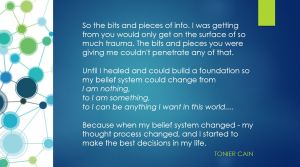
Is what we often term resilience really luck and privilege? Is resilience really the absence of all ACEs as well as the presence of one “good enough” adult in our corner? Do we consider how often the biggest protective factor of all is not having to experience adversity, in the home, the family as well as in the system?
These are big issues. I’m not sure anyone can talk about how they intertwine better than Tonier Cain. I’m listening and I keep learning.
I’m outraged by how mistreated Tonier Cain was by all who were supposed to keep her safe, healthy and well. But I know shame isn’t healing for anything or anyone.
So what do we do with the complicated truth? I no longer think we can try to simplify it more.
I go to conferences a lot and one of the things I hear said most is “evidence-based.” But what does that mean? The treatments Tonier Cain received were evidence-based and covered by insurance at the time. Can we reckon with that reality? How do we talk about the mistakes, pain, and damage we sometimes do and have had done to us, even though it’s usually not intentional?
I keep wondering what an evidence-based apology would look and sound like to give and get.
I wonder if Tonier Cain has ever received one.
Thank goodness she is sharing what she’s been through, what’s hurt and also what helps.
It’s hard to think and talk about bias and mistakes and system change, and it’s hard to trust things will really change if we don’t.
The tagline on Tonier Cain’s website reads: “Where there’s breath there’s hope.”
We can breathe deep. We can say, “Ouch” about what hurts, and “I’m sorry,” when we’ve been wrong and caused pain.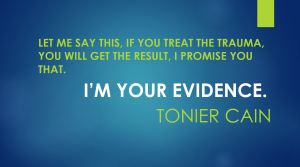
I know I’m sorry for failing to talk about community violence, race or class or oppression in all my talks about ACEs unless directly asked to at the end during Q&A.
I can change. People and systems can change.
Tonier Cain is passing down guidance as well epigenetic joy in her own family (see below).
Her words help me do what Jane Stevens always says, and that is to “prevent as well as stop traumatizing already traumatized people.”
It’s possible. Tonier Cain describes it so well.
BREAKING THE CYCLE / INTERGENERATIONAL SAFETY
“They treated my trauma with the hopes that I’d stay out of their system and it worked.
But I often wonder: Did they realize that treating my trauma was going to break the generational cycle in my family? See, my daughter doesn’t know what it’s like to be hungry, not to be loved, not to be supported. She doesn’t even know what it’s like to live in a challenging area. So, she’ll be able to give her kids what she was given and so on and so forth. And so we’re going to get a whole different generational path from here on out. In other words, the cycle has been broken.
“What if someone recognized my trauma at age nine like they did 13 years ago when I was given the opportunity to embrace trauma treatment?
“….Do we truly believe in the people that we serve?
“Let me say this, if you treat the trauma, you will get the result, I promise you that. I’m your evidence.”
For more about Tonier Cain’s life and work check out her website and the Healing Neen documentary.
Tonier Cain Deserves an Evidence-Based Apology was originally published @ ACEs Too High and has been syndicated with permission.
Sources:
Our authors want to hear from you! Click to leave a comment
Related Posts








